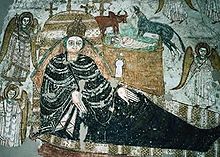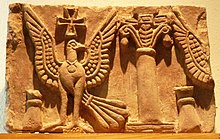Faras
Faras (formerly Ancient Greek: Παχώρας, Pakhôras; Latin: Pachoras; Old Nubian: Ⲡⲁⲭⲱⲣⲁⲥ, Pakhoras[1]) was a major city in Lower Nubia.
The site of the city, on the border between modern Egypt and Sudan at Wadi Halfa Salient, was flooded by Lake Nasser in the 1960s and is now permanently underwater.
The city reached its height during the Christian period of Nubia, when Faras was the capital of the basiliskos Silko of Nobadia.
[2] At the turn of the 1960s, UNESCO organized the Nubian Salvage Campaign to preserve monuments from the area, which was to be flooded by Lake Nasser.
[3] In the turbulent later years of Christian Nubia, Faras seems to have declined and the administrative centre moved to the more easily defended area of Qasr Ibrim.



